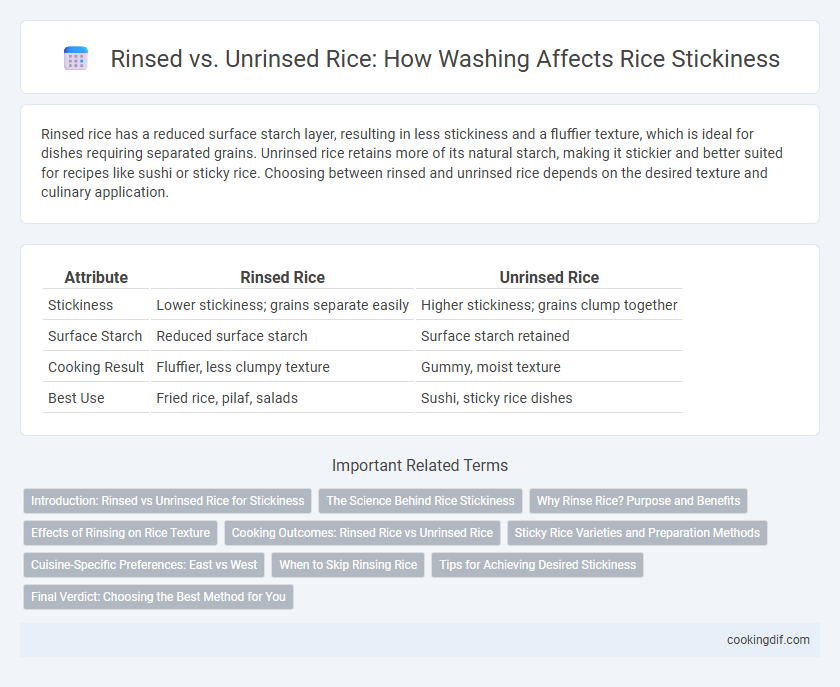Rinsed rice has a reduced surface starch layer, resulting in less stickiness and a fluffier texture, which is ideal for dishes requiring separated grains. Unrinsed rice retains more of its natural starch, making it stickier and better suited for recipes like sushi or sticky rice. Choosing between rinsed and unrinsed rice depends on the desired texture and culinary application.
Table of Comparison
| Attribute | Rinsed Rice | Unrinsed Rice |
|---|---|---|
| Stickiness | Lower stickiness; grains separate easily | Higher stickiness; grains clump together |
| Surface Starch | Reduced surface starch | Surface starch retained |
| Cooking Result | Fluffier, less clumpy texture | Gummy, moist texture |
| Best Use | Fried rice, pilaf, salads | Sushi, sticky rice dishes |
Introduction: Rinsed vs Unrinsed Rice for Stickiness
Rinsing rice removes excess surface starch, resulting in less sticky and fluffier grains. Unrinsed rice retains more starch, increasing stickiness and clumping, which benefits recipes requiring cohesive texture like sushi or sticky rice dishes. Choosing between rinsed and unrinsed rice depends on the desired consistency and culinary application.
The Science Behind Rice Stickiness
Rinsing rice removes surface starch, reducing stickiness by preventing excess amylopectin from gelatinizing during cooking. Unrinsed rice retains more starch, resulting in a stickier texture ideal for dishes like sushi and sticky rice desserts. The balance of amylose and amylopectin molecules in rice varieties fundamentally influences the degree of stickiness after rinsing or not.
Why Rinse Rice? Purpose and Benefits
Rinsing rice removes surface starch that causes excessive stickiness, resulting in fluffier, separate grains ideal for dishes like pilaf or fried rice. It also eliminates impurities, dust, and potential residues, improving overall rice texture and taste. Rinsed rice absorbs water more evenly, enhancing cooking consistency and preventing clumping.
Effects of Rinsing on Rice Texture
Rinsing rice removes excess surface starch, reducing stickiness and resulting in fluffier, separated grains after cooking. Unrinsed rice retains more starch, which increases stickiness and creates a clumpier texture desirable for dishes like sushi or risotto. The level of rinsing directly influences rice texture, affecting whether it is ideal for recipes requiring distinct grains or cohesive, sticky consistency.
Cooking Outcomes: Rinsed Rice vs Unrinsed Rice
Rinsed rice typically results in less sticky grains due to the removal of surface starch, producing a fluffier texture ideal for pilafs or fried rice. Unrinsed rice retains more starch, leading to a stickier, clumpier consistency favored in dishes like sushi or risotto. Choosing between rinsed and unrinsed rice directly impacts cooking outcomes by controlling the rice's moisture absorption and final mouthfeel.
Sticky Rice Varieties and Preparation Methods
Sticky rice varieties such as glutinous rice benefit from rinsing to remove excess surface starch, reducing excessive stickiness and preventing clumping during cooking. Unrinsed sticky rice tends to produce a denser, more adhesive texture commonly desired in certain traditional dishes like sushi or mochi. Preparation methods that involve soaking rinsed sticky rice for several hours enhance the grain's ability to absorb water evenly, yielding a tender yet cohesive final dish.
Cuisine-Specific Preferences: East vs West
Rinsed rice removes surface starch, resulting in less sticky grains preferred in Western cuisines for fluffy textures in dishes like pilafs and risottos. Unrinsed rice retains more starch, producing stickier rice favored in many East Asian cuisines such as Japanese sushi and Korean bibimbap, where cohesiveness aids in eating with chopsticks. These regional preferences reflect culinary techniques and cultural dining practices that emphasize texture balance tailored to specific dishes.
When to Skip Rinsing Rice
Skipping rinsing rice preserves surface starch, resulting in a stickier texture ideal for sushi or sticky rice dishes. Unrinsed rice retains more nutrients and B vitamins often lost during washing. Choose not to rinse when a sticky consistency is essential for the recipe or when using enriched rice varieties to maximize nutritional benefits.
Tips for Achieving Desired Stickiness
Rinsing rice removes excess surface starch, resulting in less stickiness and a fluffier texture, ideal for dishes like pilaf or biryani. Leaving rice unrinsed retains more starch, creating a stickier consistency perfect for sushi or sticky rice desserts. To achieve desired stickiness, adjust rinsing practices based on the recipe, and soak the rice appropriately to control moisture absorption for consistent texture outcomes.
Final Verdict: Choosing the Best Method for You
Rinsing rice removes excess surface starch, resulting in less sticky grains, while unrinsed rice retains this starch, producing a stickier texture ideal for sushi or sticky rice dishes. The choice depends on the desired dish consistency: rinse for fluffy, separate grains or skip rinsing for cohesive, sticky rice. Personal preference and recipe requirements ultimately guide the best method for optimal texture and culinary outcome.
Rinsed vs Unrinsed rice for stickiness Infographic

 cookingdif.com
cookingdif.com